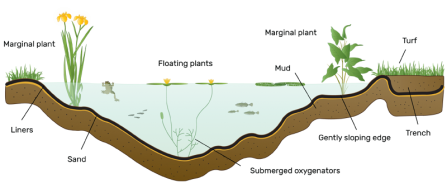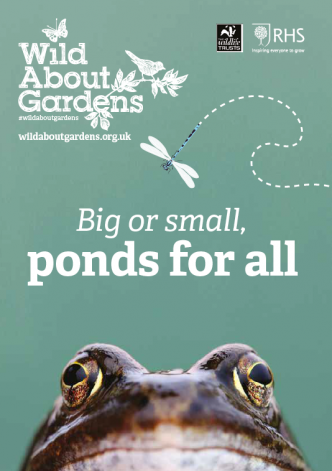
Mark Hamblin/ 2020VISION
Take the plunge!
Build a wildlife pond
The Wildlife Trusts and the RHS set up Wild About Gardens to celebrate wildlife gardening and to encourage people to use their gardens to take action to help support nature, and this year's theme is ponds.
Almost 70% of the UK’s natural ponds have now been lost and species such as dragonflies, waterbugs and the great crested newt have declined rapidly over the last 40 years.
A garden pond can provide a home for many species and is one of the best features for attracting new wildlife to the garden including hedgehogs, birds and other creatures that need a fresh drinking source.
Build a wildlife pond - Surrey Wildlife Trust (https://www.youtube.com/watch?v=ffgCcxXCqNQ)
Build a wildlife pond - Surrey Wildlife Trust
Building a wildlife pond
A well designed wildlife pond is great for nature, as well as being an attractive garden feature.
Finding the right spot
Avoid shade - a sunny, sheltered spot is best. Sun should reach the pond most of the day.
Avoid overhanging trees - rotting leaves will reduce the amount of oxygen in the pond and kill the wildlife.
Make sure you have the right tools for the job. Check your soil type - soil such as clay will be harder to dig by hand.
Dig your pond away from services such as underground gas and electricity lines.
Design and excavation
Once you have decided where to put your pond, you should mark out a suitable shape with canes or string. Ponds can be dug at most times of the year, but spring is best!
Before you start to dig, decide what you are going to do with the soil. It could be used as a nettle bed for butterflies or dug into the flower beds. Keep some aside to cover the liner.
Try to make your pond as large as the available space permits, it will be richer in wildlife and easier to maintain in a balanced state. It should be at least 0.75 metres deep in the centre to stop it freezing in winter. A good design is a kidney shape.
Incorporate gently sloping edges so that animals can get in and out and an irregular shoreline with ‘bays’ around 30-40cm deep to provide secluded areas for wildlife. Shelves and ledges will add variation in depth. When you start to dig, strip the turf to keep for edging the pond later.
Dig the hole 15-20cm deeper than the design to allow for the liner and a protective layer. Also dig a trench around the edge of the pond so you can bury the edges of the liner at the end. It is vital to check that the lip of the pond is level all the way round with a spirit level!
Lining your pond
The easiest way to line a small/medium sized pond is to lay 15cm of sand covered by a flexible butyl liner. You may also want to add a layer of protective overliner. Both should be available from your local garden or aquatic centre and staff may be able to advise you on the best material for your project.
How To Line A Pond
-
Compact the soil and remove stones, which may cause punctures.
-
Cover the hole with a layer of sand 15cm deep.
- Place the liners over the hole and position centrally. They should sink into position.
- Cover the liners with a thin layer of mud or soil to allow plants to take root.
- Place a number of irregular shaped rocks in the pond, this will create nooks and crannies for pond-life.
- Fill the pond with water. Whilst tap water is the most practical source, rain water is much more beneficial (leave the pond to fill or collect from a water butt).
- When full, secure the liner in the trench with soil. Trim the liner and edge with the turf you saved from digging the pond
To work out the amount of liner you will need, use this formula:
Length = greatest length of finished pool + twice the maximum depth.
Width = Greatest width of finished pool + twice maximum depth.
Planting your pond
Ponds can be a real haven for wildlife. Even a small pond can be alive with frogs, newts, dragonflies and many attractive plants. Leave your pond at least a week for the soil to settle before planting.
Make sure to include oxygenating plants so you don't require a pump, which will suck in and destroy all the smaller creatures.
Oxygenating submerged plants
- Curled pondweed Potamogeton crispus
- Water starwort Callitriche stagnalis
- Rigid hornwort Ceratophyllum demersum
- Water milfoil Myriophyllum spicatum
- Water crowfoot Ranunculus aquatilis
Floating leaved plants
-
Broad-leaved pondweed Potamogeton natans
-
Frogbit Hydrocharis morsus-ranae
-
Floating sweet-grass Glyceria fluitans
-
Yellow water-lily Nuphar lutea
-
Fringed water-lily Nymphoides peltata
-
Water soldier Stratiotes aloides
-
White water-lily Nymphaea alba
Shallow water emergent plants
- Amphibious bistort Persicaria amphibia
-
Water forget-me-not Myosotis scorpioides
-
Lesser spearwort Ranunculus flammula
-
Spearwort Ranunculus lingua
-
Arrowhead Sagittaria sagittifolia
-
Brooklime Veronica beccabunga
-
Bogbean Menyanthes trifoliatea
Tall emergent plants
- Flowering rush Butomus umbellatus
- Branched bur-reed Sparganium erectum
- Water mint Mentha aquatica
- Water plantain Alisma plantago-aquatica
- Greater pond-sedge Carex riparia
- Lesser bulrush Typha angustifolia
- Common reed Phragmites australis
Marginal and bog plants
- Bugle Ajuga repens
-
Marsh marigold Caltha palustris
-
Hard rush Juncus inflexus
-
Lady’s smock Cardamine pratensis
-
Yellow flag Iris pseudacorus
-
Ragged-robin Lychnis flos-cuculi
-
Purple-loosestrife Lythrum salicaria
-
Yellow loosestrife Lysimachia vulgaris
-
Marsh woundwort Stachys palustris
-
Great willowherb Epilobium hirsutum
Invasive plants to avoid
- New Zealand pygmyweed
- Water fern
- Parrot’s-feather
- Canadian / Nuttal’s waterweed
- Floating pennywort
- Curly waterweed
- Water primrose
- Water hyacinth
- Water lettuce

Wildlife pond diagram
Pond care
Your pond will require different forms of maintenance depending on the time of year.
Spring maintenance
It is important not to disturb your pond during spring as this is the time when pond insects begin to emerge and there is lots of activity below the surface.
Summer maintenance
- Keep your pond topped up with rain water from a water butt, rather than tap water, which contains chlorine and nutrients that will promote the growth of algae.
- Aim to keep pond 3/4 full with plants.
- Remove filamentous algae and duckweed.
- Watch out for invasive species and water fern. They are hard to get rid of once established.
Autumn/Winter Maintenance
Maintenance work should be carried out in autumn when there is less activity, but before pond creatures are dormant.
Every year:
Remove the looser vegetation so that just 3/4 of the pond is dense with plants.
Every 2 or 3 years:
Lift reeds, Iris and other plants with rootstocks, split and plant 1/3 back.





